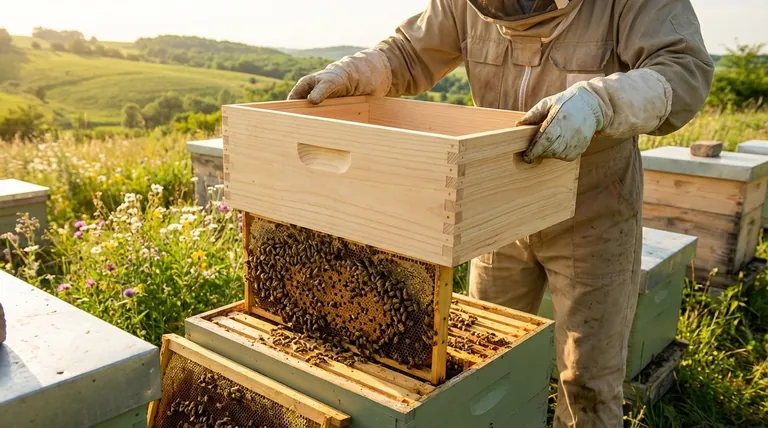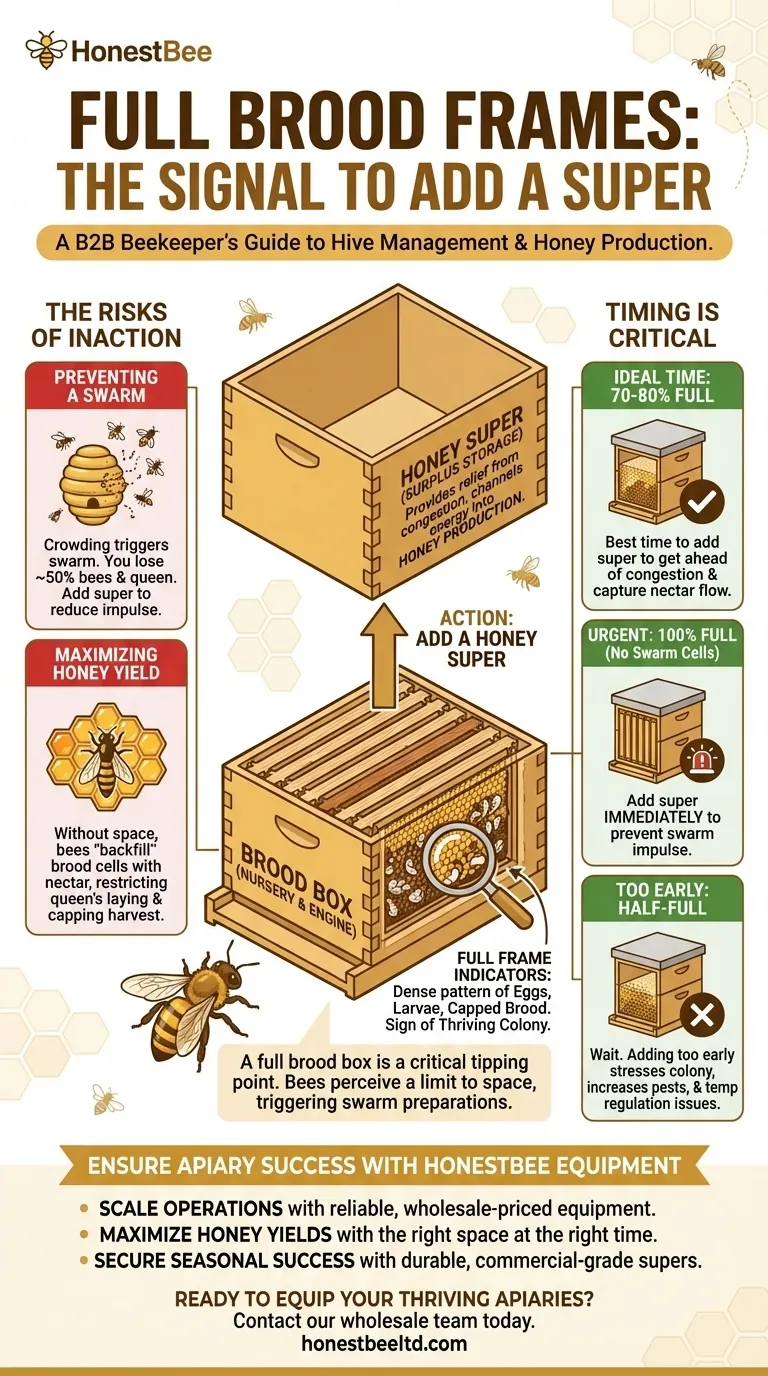When your brood frames are full, it is the most important signal your honeybee colony can send you. It means your hive is thriving, the queen is laying prolifically, and the population is expanding rapidly. This isn't a problem to be solved, but a critical indicator that the bees desperately need more space to store incoming nectar, making it the primary trigger for adding a honey super.
A full brood box is a sign of a healthy, growing colony on the verge of becoming congested. Failing to provide more space at this key moment risks losing half your bees to a swarm, while adding a super channels their energy directly into honey production.

The Brood Box: Your Colony's Engine
The brood box, or brood chamber, is the heart of the hive. It's the nursery where the queen lays eggs and the next generation of bees is raised. Its condition tells you everything about the colony's health and trajectory.
What "Full" Actually Means
A "full" brood frame isn't just one thing. It's a dense pattern of eggs, developing larvae, and capped brood (pupae).
Seeing frames packed like this signifies a productive queen and a colony with a rapidly growing workforce. It's the visual proof of a successful build-up.
The Tipping Point of Congestion
While a full brood box is a positive sign of strength, it also represents a critical tipping point.
For bees, space is a resource. When the nursery is full, they perceive a limit to their ability to expand and store food, which is the primary trigger for them to begin swarm preparations.
Why a Full Brood Box Demands Action
Observing a full brood chamber requires a direct and timely response from the beekeeper. Your action—or inaction—will determine the hive's focus for the rest of the season.
Preventing a Swarm
Swarming is the colony's natural method of reproduction. When the hive becomes too crowded, the bees will raise a new queen, and the original queen will leave with roughly half the workforce.
By adding a super, you provide immediate relief from this congestion. This new, empty space gives the bees a project and signals that the hive has room to grow, drastically reducing the impulse to swarm.
Maximizing Honey Production
A super is essentially an empty pantry placed on top of the main hive. You are giving the bees a dedicated place to store surplus honey.
Without this space, foraging bees will begin storing nectar in any available empty cells within the brood box. This is known as backfilling and it restricts the queen's ability to lay eggs, slowing colony growth and capping your potential honey harvest.
Understanding the Trade-offs of Timing
The decision of when to add a super is just as important as the decision to add one. Both acting too early and acting too late have consequences.
The Risk of Adding a Super Too Early
If you add a super before the colony is strong enough, the bees may struggle. They will have a much larger space to patrol and defend against pests like wax moths and small hive beetles.
A smaller population may also have difficulty maintaining the proper temperature and humidity in an oversized cavity, stressing the colony.
The Cost of Adding a Super Too Late
The primary consequence of waiting too long is losing a swarm. When the bees leave, you lose your original queen and a huge portion of your foraging workforce.
A hive that has swarmed will spend weeks or even months rebuilding its population and will rarely produce any surplus honey for the remainder of the season.
How to Apply This to Your Hive
Use the state of your brood box as your guide. It provides a clear roadmap for when to intervene and when to wait.
- If your top brood box is 70-80% full of bees, brood, and resources: This is the ideal time to add a super to get ahead of congestion and capture the nectar flow.
- If your brood frames are full and you also see swarm cells: You must act immediately by both adding space and managing the swarm cells to prevent the hive from splitting.
- If your brood frames are only half-full: It is too early to add a super. Your priority should be allowing the colony to continue building its population.
Ultimately, a full brood box is the hive communicating its success and its needs. By learning to read this sign and acting decisively, you partner with your bees to ensure a healthy colony and a productive season.
Summary Table:
| Brood Box Status | Beekeeper Action | Key Outcome |
|---|---|---|
| 70-80% Full | Add a honey super. | Prevents congestion, channels bees into honey production. |
| 100% Full (No Swarm Cells) | Add a super immediately. | Urgently prevents swarming impulse. |
| 100% Full (With Swarm Cells) | Add a super AND manage swarm cells. | Emergency action to stop the hive from splitting. |
| Half-Full or Less | Wait; allow colony to build strength. | Adding a super too early can stress the colony. |
Ensure Your Apiary's Success with the Right Equipment
A full brood box is a critical moment for your hive's productivity. Don't let a lack of equipment risk a swarm or limit your honey harvest. HONESTBEE supplies commercial apiaries and beekeeping equipment distributors with the high-quality, durable supers and foundations needed to manage strong, expanding colonies effectively.
Partner with us to:
- Scale your operations with reliable, wholesale-priced equipment.
- Maximize honey yields by providing your bees with the space they need, when they need it.
- Secure your seasonal success with equipment built for commercial demands.
Ready to equip your thriving apiaries? Contact our wholesale team today to discuss your needs and keep your colonies productive.
Visual Guide

Related Products
- Langstroth Honey Bee Box Hive Boxes for Different Depths
- Professional 500g Sectional Comb Honey Frame System for Beekeeping
- Economy Small Scale Honey Dryer Dehumidifier Thickening Machine
- High-Efficiency Diamond Maze Bee Escape for Clearing Supers
- Commercial 48-Frame Stainless Steel Honey Extractor
People Also Ask
- How deep is a medium bee box? Unlock the Key to a Versatile and Manageable Hive
- How is checking honey supers in a Langstroth hive different from inspecting Honey Flow supers? A Guide to Disruptive vs. Non-Invasive Methods
- What is the best time to inspect a hive? Optimize for Bee and Beekeeper Safety
- What factors should beekeepers consider when choosing between wooden and polystyrene hives? Maximize Bee Health and Honey Production
- How should hive boxes be aligned after reassembly? Ensure a Perfect Seal for Hive Health



















